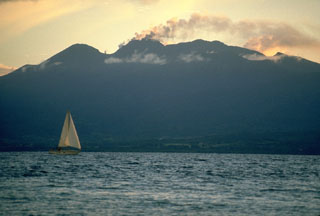Report on Soufriere Guadeloupe (France) — April 1977
Natural Science Event Bulletin, vol. 2, no. 4 (April 1977)
Managing Editor: David Squires.
Soufriere Guadeloupe (France) Decreased seismic and surface activity
Please cite this report as:
Global Volcanism Program, 1977. Report on Soufriere Guadeloupe (France) (Squires, D., ed.). Natural Science Event Bulletin, 2:4. Smithsonian Institution. https://doi.org/10.5479/si.GVP.NSEB197704-360060
Soufriere Guadeloupe
France
16.044°N, 61.664°W; summit elev. 1467 m
All times are local (unless otherwise noted)
Surface and seismic activity have declined considerably at Soufrière since the peak of the volcano-seismic crisis in August 1976 (table 5). The most recent phreatic explosion occurred on 1 March, after which solfataric activity continued into April from the uppermost craters but diminished on the flank and in the Col de l'Echelle, just SE of the summit dome. Ash was emitted for portions of 20 days 1 January-15 April.
Geological Summary. La Soufrière de la Guadeloupe volcano occupies the southern end of Basse-Terre, the western half of the island of Guadeloupe. Construction of the Grand Découverte volcano about 200,000 years ago was followed a Plinian eruption and caldera formation about 100,000 years later, and then by construction of the Carmichaël volcano within the caldera. Two episodes of edifice collapse and associated large debris avalanches formed the Carmichaël and Amic craters about 11,500 and 3,100 years ago, respectively. The present volcano subsequently grew within the Amic crater. The summit consists of a flat-topped lava dome, and several other domes occur on the southern flanks. Six phreatic explosive eruptions since 1690 opened radial fractures across the summit lava dome. The phreatic eruptions in 1976-77 caused severe economic disruption when Basse-Terre, the island's capital city immediately below the volcano, was evacuated.
Information Contacts: M. Feuillard, Lab. de Physique du Globe.

